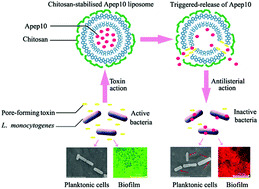A chitosan-coated liposome encapsulating antibacterial peptide, Apep10: characterisation, triggered-release effects and antilisterial activity in thaw water of frozen chicken
Abstract
Contamination of Listeria monocytogenes in food and their processing environment is a focus of attention in the food industry. To achieve the controlled release of antibacterial agents to a food processing environment contaminated by L. monocytogenes, chitosan-stabilised liposomes encapsulating Apep10 (GLARCLAGTL), an antibacterial peptide derived from boiled-dried anchovies, were prepared by utilising listeria toxins to activate the peptide release. Characteristics including the particle size, polydispersity index (PDI), encapsulation efficiency (EE), and morphology of the chitosan-coated Apep10 liposomes were investigated. The chitosan liposomes were more stable than their uncoated counterparts, which indicated that the coating of chitosan on the surface of the liposomes inhibited undesirable vesicle fusion and payload release during storage. However, once the chitosan-stabilised liposomes encountered L. monocytogenes, which secretes pore-forming toxins, the encapsulated antibacterial peptide was released and it exerted antimicrobial effects on the strain. The results of time-kill inhibition, scanning electron microscopy (SEM), crystal violet staining and confocal laser scanning microscopy (CLSM) images demonstrated that these liposomes have favourable antibacterial and anti-biofilm activities against L. monocytogenes in the thaw water of frozen chicken. This bacterial toxin-enabled release of the encapsulated antibacterial peptide from chitosan-coated liposomes provides an effective approach for the control of listerial contamination. This technique can be broadly applied to treat contamination by a variety of pathogens that secrete pore-forming toxins.


 Please wait while we load your content...
Please wait while we load your content...